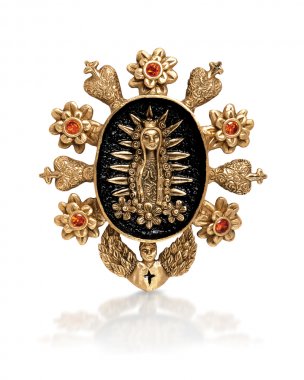Mexico: Bringing It with Her
Mexico: Bringing It with Her
When Lorena Angulo was a child in Mexico, her father worked in construction for the government, so “we moved everywhere.” One journey took her to the southern state of Chiapas, home to many indigenous peoples, where she noticed the jewelry some of them wore, passed down from parent to child. “It was so vintage and so antique and so Mexican,” Angulo says. “And gold that is – you can’t see that gold anymore, nowadays. That doesn’t exist anymore in the commercial world.”
Though she didn’t always appreciate it at the time, the 49-year-old metalsmith credits her transient childhood with the chance to absorb the cultural knowledge that has led to her artistic success. “When I was older, I realized how lucky we were, to be exposed to so many different states and so many different traditions, because each state is a different story in Mexico.” The work Angulo makes now – jewelry and other metal pieces that channel traditional Mexican motifs through a contemporary perspective – could only come from someone with an extensive understanding of the country’s diverse cultural heritage. “Clay and ceramics from Oaxaca and sculptures and pieces made with paper from Guadalajara, Michoacán – we have so much variety,” she says. “So I think all those exposures that I had when I was a kid are reflected in the work I do with jewelry now.”
Although her itinerant upbringing provided Angulo with an artistic education, it was only after leaving Mexico that she understood what it meant to her. She attended college at the University of Texas-El Paso, where she studied advertising and mass communications, but left school and moved to New Jersey “when life got in the way.” “You start really noticing what you like and miss that you don’t have anymore,” Angulo says. “In New Jersey, specifically the area where I was living, I didn’t have a lot of exposure to Latin American or Hispanic culture.” So she set to making her own work: bas-reliefs she made from aluminum, using wooden tools to emboss images inspired by Mexican folk art. “It’s like a painting; you had to frame it. They were inspired by Diego Rivera, mainly, and a lot of alcatraces.”
When she returned to Texas to be closer to family – this time San Antonio, where she still lives – Angulo took her first class in metalsmithing, at the Southwest School of Art. There, she developed the technique to match her knowledge – “trying to understand all those crazy ideas I had in my head.” She grew to love metal clay, a sculpting medium that can be fired, leaving only the metal; it allows her to achieve a high degree of intricacy and detail, even in small pieces.
You can see the full scope of her trajectory – the inspiration of her childhood, the rigor of her schooling – in her current portfolio. She adorns earrings, necklaces, and rings with elaborate imagery ubiquitous in Mexico – flaming hearts, crosses, skulls. Colorful beads sometimes complement the metalwork, but it’s her sculptural skill that holds your attention. She also responds to recent events; when her father died in early 2019, she began incorporating more Day of the Dead symbols. There is a tip-of-the-iceberg aspect to her work; you sense – rightly – that a huge history grounds her pieces. Angulo is quick to redirect the credit. “It comes from my culture,” she says. “I didn’t invent anything.”
Angulo has, in a way, come full circle. She now teaches in the metal department at the Southwest School of Art, where she hopes to give her students the same gift her instructors once gave her: the ability to tap into their personal artistic essence, much as she found hers by tapping into memories of her formative years. “Since I started teaching,” she says, “I wanted to let my students understand that the most important part of learning is not just learning the technique; it’s trying to express their own, unique voices.” She is less interested in the aesthetic specifics of the work than in the spirit that informs it. “They all try to have a story behind what they are doing.”
Angulo’s own story still has plenty to tap into, from more childhood memories to a recent bout with cancer, which is currently in remission. She is grateful that she can recall the good and bad alike. “Everything is in me,” she says. “I just remember something – a smell, a color – and it brings me back.”












